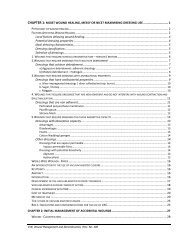permethrin intoxication of cats bibliography - Centre for Veterinary ...
permethrin intoxication of cats bibliography - Centre for Veterinary ...
permethrin intoxication of cats bibliography - Centre for Veterinary ...
Create successful ePaper yourself
Turn your PDF publications into a flip-book with our unique Google optimized e-Paper software.
CITATION YEAR COUNTRY<br />
<strong>of</strong><br />
AUTHOR<br />
Association 216(5): 729-729.<br />
(2007). "Cats 'killed by flea treatment'." Saturday,<br />
10 November 2007, 10:35 GMT. Retrieved 10<br />
March, 2009, from<br />
http://news.bbc.co.uk/1/low/uk/7088397.stm.<br />
(2007). "Pink page 2: Permethrin." Journal <strong>of</strong> Feline<br />
Medicine & Surgery 9(5): VI-VI.<br />
NOTES<br />
2007 UK Hundreds <strong>of</strong> <strong>cats</strong> may have died because their owners mistakenly treated them with<br />
anti-flea products intended <strong>for</strong> dogs, a study suggests. The <strong>Veterinary</strong> Poisons<br />
In<strong>for</strong>mation Service found that one in 10 <strong>cats</strong> referred to it had died after being<br />
exposed to <strong>permethrin</strong>. The chemical is used in flea treatments <strong>for</strong> dogs but is very<br />
toxic to <strong>cats</strong>, said Alex Campbell <strong>of</strong> VPIS. VPIS wants clearer warnings to be displayed<br />
on canine treatments. Mr Campbell said the substance was present in many products,<br />
but in very low concentrations. If accidentally applied to <strong>cats</strong> they can show "severe<br />
clinical signs" and need two or three days <strong>of</strong> intensive veterinary treatment if they are to<br />
survive. Convulsions "You'd find it in ant powders and a few things like that, but in<br />
those sort <strong>of</strong> products it's in very low concentrations, so it doesn't usually cause<br />
problems in either <strong>cats</strong> or dogs," he told BBC Radio 5Live. "However, it is occasionally<br />
used in spot-on flea treatments <strong>for</strong> dogs and if you accidentally apply these to <strong>cats</strong>, or<br />
you've treated your dog and your cat comes into contact with the dog, and actually<br />
manages to groom some <strong>of</strong> it <strong>of</strong>f or whatever, then potentially the cat can get severe<br />
clinical signs. "This substance is very toxic to <strong>cats</strong>." In a study <strong>of</strong> 286 cases in which<br />
canine spot-on <strong>permethrin</strong> preparations had been used on <strong>cats</strong> found that 97% showed<br />
signs <strong>of</strong> poisoning. Around 90% displayed symptoms <strong>of</strong> twitching and convulsions, with<br />
one in 10 dying or having to be put down. However, Mr Campbell said poisoning may<br />
be more widespread as not all vets report every case, nor do they all use the VPIS,<br />
which is part <strong>of</strong> Guy's and St Thomas' NHS Foundation Trust.<br />
2007 UK Refers to: Clinical effects and outcome <strong>of</strong> feline <strong>permethrin</strong> spot-on poisonings reported<br />
to the <strong>Veterinary</strong> Poisons In<strong>for</strong>mation Service (VPIS) London, Sutton NM, Bates N and<br />
Campbell A(2007) Journal <strong>of</strong> Feline Medicine and Surgery 9, 335 highlighted the lethal<br />
risks <strong>of</strong> <strong>permethrin</strong>-based dog spot-on treatments being inappropriately applied to <strong>cats</strong>.<br />
A joint press release by VPIS and the Feline Advisory Bureau drew attention to the<br />
problem. The report is a review <strong>of</strong> 286 cases reported to VPIS where such canine<br />
spoton <strong>permethrin</strong> preparations have been used on <strong>cats</strong>. Of these cases, 97 per cent<br />
<strong>of</strong> the <strong>cats</strong> had signs <strong>of</strong> poisoning, 88 per cent had twitching or convulsions and 10.5<br />
per cent <strong>of</strong> the <strong>cats</strong> died or were euthanased. Although these data are startling, the<br />
VPIS feels that they are an under-representation <strong>of</strong> the scale <strong>of</strong> the problem. The<br />
veterinary press <strong>of</strong>ten receives letters on the topic from vets in practice and the<br />
<strong>Veterinary</strong> Medicines Directorate (VMD) highlighted the problem in 2000 – ‘These<br />
spot-on products are sold through UK pet stores or supermarkets and veterinary<br />
surgeons should be alert to the possibility <strong>of</strong> being presented with feline cases’ (Gray,<br />
<strong>Veterinary</strong> Record 147, p556). Permethrin is one <strong>of</strong> a group <strong>of</strong> insecticidal compounds<br />
called pyrethroids, which have widespread use in pet flea treatments, ant-killers, and<br />
other products <strong>for</strong> control <strong>of</strong> pest insects. Although pyrethroids are considered to have<br />
PERMETHRIN INTOXICATION OF CATS 28 Novermber 2009 Page 2 <strong>of</strong> 26






